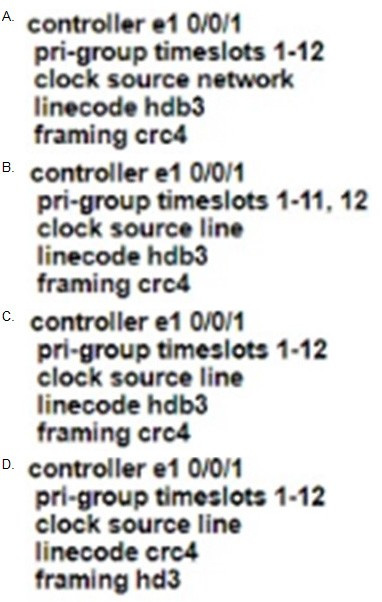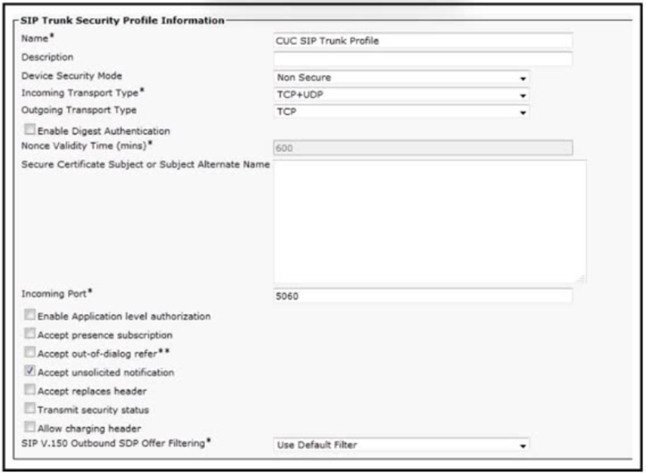Exam Details
Exam Code
:350-801Exam Name
:Implementing and Operating Cisco Collaboration Core Technologies (CLCOR)Certification
:CCNP CollaborationVendor
:CiscoTotal Questions
:500 Q&AsLast Updated
:Mar 30, 2025
Cisco CCNP Collaboration 350-801 Questions & Answers
-
Question 21:
Refer to the exhibit.

An administrator must replace the T1 card with an E1 card. What is the correct configuration if the administrator was asked to configure 12 time slots?

A. Option A
B. Option B
C. Option C
D. Option D
-
Question 22:
Which certificate does the Disaster Recovery System in Cisco UCM use to encrypt its communications?
A. Cisco Tomcat
B. CAPF
C. Cisco CallManager
D. IPsec
-
Question 23:
When designing location-based CAC, how much overprovisioning is calculated for video bandwidth?
A. 10%
B. 15%
C. 20%
D. 25%
-
Question 24:
Location-based call admission control is used in Cisco UCM to control the amount of bandwidth allowed between predefined locations. What must be considered when calculating the number of calls that can be made?
A. A limit of 900 kb is the total amount of bandwidth used for the sum of the media and signaling in the calls. The system allows for an actual of 20% overhead of IP packet headers. This is to compare the use of ISDN lines with no IP overhead.
B. A limit of 900 kb Is the total amount of bandwidth used for the sum of calls of the de ned codec including headers and media traffic.
C. A limit of 900 kb is the total amount of bandwidth used for the sum of calls. The use of compression does not impact the amount of calls because only the codec definition is considered when calculating the CAC in Cisco UCM.
D. A limit of 900 kb is the total amount of actual used RTP traffic so the oversubscription can be done for multiple calls adding Its maximum RTP stream requirements.
-
Question 25:
Which two media encryptions should be used when configuring SRTP between Cisco UCM and Cisco VCS Expressway? (Choose two.)
A. optional
B. pass-through
C. priority
D. mandatory
E. none
-
Question 26:
Refer to the exhibit.

An engineer configured NTP on Cisco UCM and runs the utils ntp status command from Cisco UCM CLI and receives an error message. How is this issue mitigated and fixed?
A. Use an external NTP server and allow communication on port 53.
B. Ensure that Cisco UCM can communicate with the NTP server on port 53 and have a Windows NTP server configured with NTPv3.
C. configure the NTP server to answer requests on port 443.
D. Ensure that Cisco UCM can communicate with the NTP server on port 123 and have a Linux NTP server configured with NTPv4.
-
Question 27:
What is a capability of a DNS server?
A. to assign an IP address to a host
B. to convert an IP address into a MAC address
C. to assign a hostname to a host
D. to convert a hostname to an IP address
-
Question 28:
How does an administrator ensure compliance with ITU-T G.114 latency requirements when deploying voice and video applications over routes that include a geostationary satellite?
A. For voice and video applications over satellite, Cisco recommends using WAN optimization compression, which will save space or time of the transmission. The latency will then be below the recommended latency threshold for voice.
B. Using G.729 voice codec Instead of G.711 voice codec will reduce the packet size and the latency to stay within the recommended threshold.
C. The satellite is 35,786 km (22,236 miles) above sea level (from the equator), so an engineer will not get below 150 ms latency in one direction and will need to manage the expectation of the user.
D. The application will work because it will be below the recommenced latency requirement If an engineer uses compressed headers to speed up the voice packets.
-
Question 29:
How does WRED prevent congestion?
A. It marks which packets to drop randomly.
B. It drops packets selectively based on the IP precedence value.
C. It marks which packets to drop based on how much traffic the client sent.
D. It drops packets that have a higher DSCP value last.
-
Question 30:
Refer to the exhibit.

An engineer is integrating Cisco UCM with Cisco Unity Connection via SIP. Which two boxes should be checked to complete the configuration of the SIP trunk security profile? (Choose two.)
A. to enable application-level authorization
B. to enable digest authentication
C. to accept out-of-dialog refer
D. to accept presence subscription
E. to accept replaces header
Related Exams:
300-810
Implementing Cisco Collaboration Applications (CLICA)300-815
Implementing Cisco Advanced Call Control and Mobility Services (CLACCM)300-820
Implementing Cisco Collaboration Cloud and Edge Solutions (CLCEI)300-835
Automating Cisco Collaboration Solutions (CLAUTO)350-801
Implementing and Operating Cisco Collaboration Core Technologies (CLCOR)
Tips on How to Prepare for the Exams
Nowadays, the certification exams become more and more important and required by more and more enterprises when applying for a job. But how to prepare for the exam effectively? How to prepare for the exam in a short time with less efforts? How to get a ideal result and how to find the most reliable resources? Here on Vcedump.com, you will find all the answers. Vcedump.com provide not only Cisco exam questions, answers and explanations but also complete assistance on your exam preparation and certification application. If you are confused on your 350-801 exam preparations and Cisco certification application, do not hesitate to visit our Vcedump.com to find your solutions here.